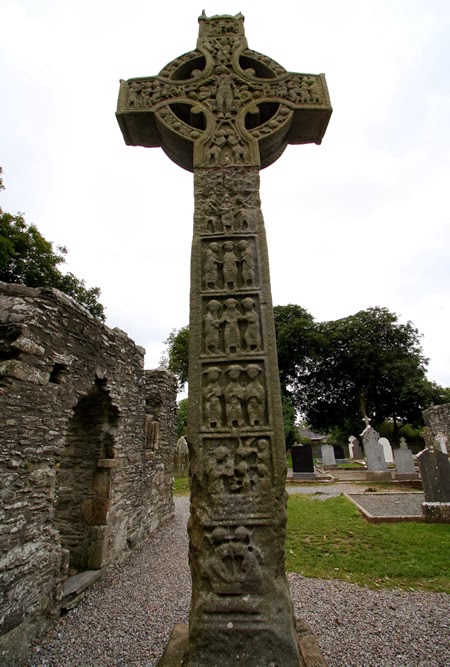 |
| Celtic Christianity |
A variety of modern sectarian and special interest groups, from New Age cults to Irish nationalists to feminists to independent Christians, claim Celtic roots for their drive and inspiration. With so many competing claims it is difficult to clear away the partisan fervor from the historical realities surrounding Celtic spirituality and cultural identity.
Among the giants in this tradition are the likes of Patrick (d. 461 c.e.), Brendan the Navigator (d. 577 c.e.), Columban (d. 615 c.e.), and Brigid (legendary). Among its gigantic achievements are the Book of Kells and a corpus of ballads and stories that make it one of the earliest European vernacular literatures.
Celtic spirituality is an inexact term reflecting the identity of an emigrating and outgoing people who adapted well wherever they wandered. It is usually applied to the native peoples of Ireland, Britain, and Brittany, bound by the language of Gaelic and (later) Hiberno-Latin.
  |
These people spread into ancient Gaul (France), Spain, Italy, and even Galatia in present-day Turkey; their religious pilgrims were known in the ancient world for their visits throughout the lands of the Middle East. Eventually Christian preachers from Celtic lands were known for re-Christianizing and recivilizing Europe after the so-called Dark Ages, so it is no wonder that Celtic spirituality is claimed by many groups.
No one is sure when Christianity reached western Celtic parts, but some Christian presence must have been established by 431 c.e. when Pope Celestine I sent a bishop to Ireland. Perhaps shortly thereafter the Western Latin Church commissioned the legendary Patrick for missionary work on the island. Thus, though Celtic spirituality shows some native distinctiveness, it was from the beginning associated with the ecclesial structure and faith of the Western Church and not just an indigenous and autonomous Christianity.
In fact the earliest artifacts discovered show Irish Christianity to be found among the wealthy classes, who used typical icons and conventional symbols to show their spirituality. Most likely they owed their faith to the fervor of the Western Church to spread Christianity, even if most of their land never was under the Roman Empire.
After the mid-400s c.e. when the Romans retreated from Britain to the European continent, contacts with the Western world diminished. The Celts were forced more wholly to reconnect with their native roots. This tendency was intensified when the Saxons arose in Britain and threatened to take Celtic lands. Meanwhile the minority Christian population repudiated residual Western Church influences because of the worldliness and corruption of many of its institutions and personnel.
The church did not respond to the alienation of the Celtic Christians until 605 c.e. when Pope Gregory the Great sent Augustine of Canterbury to parley with the Irish. The pope recognized the need for a council, showing that Celtic Christianity was a force to be reckoned with. Unfortunately, the talks completely broke down. Finally in 640 c.e. the Irish Church acceded to some of the pope’s requests.
Celtic spirituality developed in a window of time from the mid-fifth century to the mid-seventh century c.e. Its features included a different religious calendar (meaning that the Irish celebrated Easter on a different date), a different pastoral structure (meaning that the Irish had their own pastors and pastoral jurisdictions), and a different popular piety (meaning that native Irish myths became incorporated into Celtic Christianity).
The pastoral system of the Irish recognized the authority of pious monks and their monasteries and did not pay attention to formal boundaries of parish and diocese as the Western Church normally did. Instead of bishops and theologies they esteemed abbots and superiors, both men and women, who proved that they could preserve cosmic order through their personal sanctity and mystical powers.
The Celtic Church never rejected the office of the pope and institutions of the Western Church, but it tended to downplay their role and effectiveness in true spirituality. Its pastoral system bears remarkable similarity to that of the Desert Fathers and Oriental Orthodox churches (of the Copts, Syrian Orthodox, and others). There may have been limited and organic exchanges based on Celtic wanderings and pilgrimages.
The popular piety of the Irish shows the incorporation of mythic Celtic heroes into Christian stories. The story of St. Brigid, for example, founder of Kildare Abbey, may well be based on Brigid, daughter of the Celtic god Dagda, whose name graces so many places in Ireland. St. Brigid is not based on the traditional Mary, mother of Jesus, but on her namesake, who was a healer and creative force for the gods.
Celts also had less a sense of the Latin notion of original sin. The world is not cursed with the fall of the human parents Adam and Eve, as the great Western Church thinker Augustine said. It is rather a place for humans to steward and show personal discipline so as to go to heaven.
There is a heightened sense of the nearness of the divine to the created order. The ideal Christian in Celtic spirituality is the monk in the monastery who lives a life of self-control and prayer: The monk shows that his or her life can be disciplined and the world can be civilized and ordered.
If nothing else, Celtic spirituality shows an alternative to the logic-driven and doctrinal approach of the West. It values independence of thought and the Power of personal sanctity. However, it is hardly nonstructured or spontaneous or wholly unique.
It is not separate from the Christian religion, and probably is best viewed as a hybrid of Latin theology and native beliefs. By the 11th–12th centuries the special characteristics of Celtic spirituality were completely submerged in the Western Church, much as the Desert Father spirituality is a part of the Eastern Greek Church.